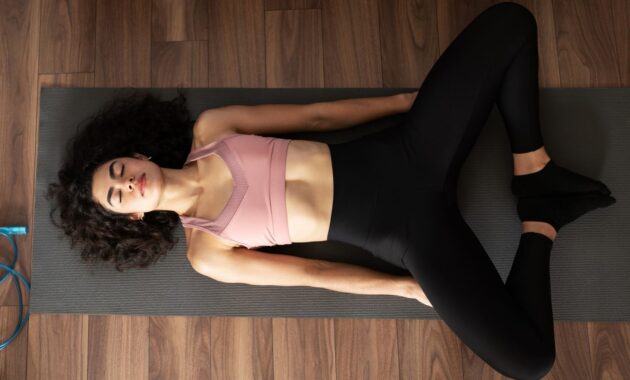Performing reclining bound angle pose relaxes the mind and body. Here are the benefits of supta baddha konasana and how to do it.
Supta baddha konasana, also known as the reclining bound angle pose, is a yoga pose that combines relaxation, meditation, and gentle stretching. This asana holds significant importance in the world of yoga, providing numerous benefits for both the body and mind. It helps the body relax and loosen up. In this pose, you lie on your back with your knees open to the sides and your feet together, which releases the muscles in your chest, abdomen, groin, and legs. It can lead to more relaxed breathing and clearer thinking. Additionally, it gives you relief from digestive problems and menstrual cramps. Let’s explore the benefits of the reclining bound angle pose and how to do supta baddha konasana.
What is supta baddha konasana or reclining bound angle pose?
Supta baddha konasana is a term from the Sanskrit language that describes a yoga pose. “Supta” means reclining, “Baddha” means bound, and “Konasana” means angle pose. During this asana, practitioners lie on their backs with the soles of their feet pressed together, creating a diamond shape with their legs. Plus, the name supta baddha konasana reflects the key elements of the pose. “Reclining” indicates the posture, “Bound Angle” refers to the position of the legs, and “Pose” signifies the overall yoga asana. This combination aptly describes the serene and restorative nature of the pose.

What are the benefits of reclining bound angle pose?
1. Relieves stress and anxiety
“Supta baddha konasana encourages deep relaxation by calming the nervous system and alleviating stress and anxiety. The gentle opening of the chest and abdomen promotes a sense of serenity as well, says Yoga Expert Dr Hansaji Yogendra.
Also Read: Yoga for stress relief: Try this 5-minute yoga flow daily for the ultimate relaxation
2. Reduces stiffness
The asana stretches the hip flexors and groin muscles, enhancing flexibility and reducing stiffness. Regular practice can contribute to increased mobility in these areas.
Also Read

3. Improves blood circulation
By elevating the legs and opening the chest, supta baddha konasana facilitates improved blood circulation. This can be beneficial for individuals with circulatory issues and helps in reducing swelling in the legs.
4. Stimulates abdominal organs
The gentle compression of the abdomen in this pose stimulates the abdominal organs, aiding digestion and promoting a healthy functioning digestive system.
5. Enhances lung capacity
The open chest and relaxed breathing associated with supta baddha konasana contribute to increased lung capacity. This can be particularly beneficial for individuals seeking to improve respiratory function.
6. Alleviates menstrual discomfort
For women, practicing this pose may help alleviate menstrual discomfort by relaxing the pelvic region and reducing tension in the lower abdomen.
7. Promotes restful sleep
The meditative and calming nature of supta baddha konasana can induce a state of deep relaxation, making it an excellent practice for promoting restful sleep.

How to do a reclining bound angle pose?
Here’s a step by step guide to perform this yoga asana:
- Step 1: Lie down on your back.
- Step 2: Bend your knees and maintain your feet flat on the ground.
- Step 3: Open your knees to either side, bringing the soles of your feet together. The legs should be positioned similarly to Cobbler’s Pose (Baddha Konasana).
- Step 4: You can place your arms in any comfortable position. You can also rest them on your thighs, rest them overhead, or form a T shape with them out by your sides.
- Step 5: Stay still for a few minutes while gravity helps to deepen your stretch. Take regular breaths while holding the stance.
- Step 6: Reach down and return your knees to the original positions. Next, turn to one side and sit up using your hands as support.
Are there any side effects of supta baddha konasana or reclining bound angle pose?
While supta baddha konasana is generally safe for most people, there are some things you need to be aware of. “People with hip or knee injuries should exercise caution, as excessive force or improper alignment may exacerbate these issues. Pregnant women, especially in the later stages of pregnancy, should consult with a healthcare professional before attempting this pose,” says the expert.
Who should avoid supta baddha konasana or reclining bound angle pose?
- Recent injuries: People with recent injuries to the hips, knees, or lower back should avoid or modify supta baddha konasana to prevent further strain.
- Pregnancy: Pregnant women, especially those in the second and third trimesters, should approach this pose with caution and seek guidance from a qualified prenatal yoga instructor or healthcare provider.
- Severe lower back pain: Individuals with severe lower back pain should exercise caution, as the reclined position may exacerbate discomfort.
The best time to do reclining bound angle pose
Supta baddha konasana can be practiced at any time of the day, but many practitioners find it particularly beneficial as part of a bedtime routine. The calming effects of the pose can help prepare the body and mind for a restful night’s sleep, recommends Dr Yogendra.
#Reclining #bound #angle #pose #Benefits #supta #baddha #konasan
